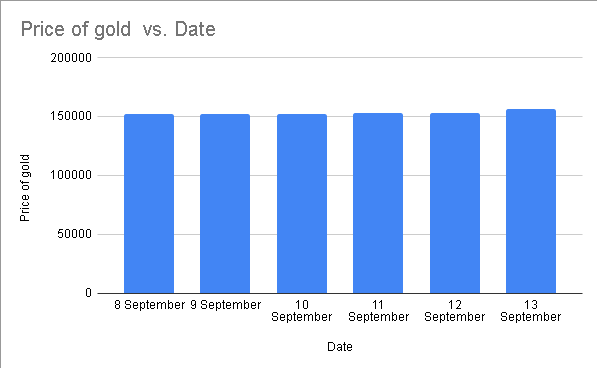KATHMANDU: Economic Digest offers a concise yet comprehensive overview of significant business happenings in Nepal, presented in easily digestible summaries.
During the week of September 8th to 13th, 2024, Nepal’s gold prices fluctuated significantly, starting at Rs 152,100 and experiencing erratic changes, including a correction from an erroneous drop to Rs 15,200 to a recovery reaching Rs 156,300 by Friday.
This volatility highlights both strong investor demand and potential market overvaluation.
Concurrently, the NEPSE index showed instability, initially falling from 2701.90 to 2610.21 before rebounding to 2688.53, reflecting market volatility and a late recovery.
The Nepal Rastra Bank’s decision to withdraw Rs 100 billion to manage liquidity, coupled with the government’s import authorization for 30,000 metric tons of sugar with a 50% duty waiver, underscores efforts to stabilize financial and commodity markets.
Additionally, the government’s Inland Revenue Mobilization Strategy 2024 aims to enhance tax revenue and streamline the tax system to support economic development and reduce the budget deficit.
Gold prices in Nepal surge midweek, ending at Rs 156,300
During the week of September 8th to 13th, 2024, gold prices in Nepal demonstrated significant volatility, starting at Rs 152,100 on Sunday.
The following day, prices inexplicably dropped to Rs 15,200, likely due to a typographical error, with the corrected figure being Rs 152,200.
The market then showed a gradual recovery, with prices rising to Rs 152,400 on Tuesday and further to Rs 153,400 by Wednesday, reflecting a period of positive sentiment or reactions to external economic factors.
Thursday saw a slight decrease to Rs 153,300, indicating possible market stabilization or profit-taking after the earlier gains.
However, the substantial surge to Rs 156,300 on Friday suggests a strong bullish trend, potentially driven by heightened investor demand or significant global market shifts.

This final spike, while indicative of robust market momentum, also raises concerns about potential overvaluation and speculative activities. Overall, while the week’s trend is largely positive, the volatility and final high underscore the need for cautious investment.
NEPSE index experiences volatile week
The NEPSE index experienced notable volatility from September 8th to 12th, 2024, beginning at 2701.90 and declining steadily to 2610.21 by September 11th, reflecting a total drop of 91.69 points or -3.39% over the initial three days.
The decline was marked by a significant 2.06% drop on September 9th and a continued decrease on September 10th and 11th, suggesting persistent negative sentiment or adverse market conditions.
However, the index rebounded sharply on September 12th, closing at 2688.53 with a 3% gain, indicating a strong recovery driven by improved investor confidence or positive developments.
Last week’s volatility highlights underlying market instability and a reactive investor base, where initial bearish trends were later countered by a significant recovery, underscoring the importance of staying attuned to both market sentiment and external factors impacting NEPSE.
NRB to withdraw Rs 100 billion from banking system
To manage excess liquidity, the Nepal Rastra Bank (NRB) plans to withdraw Rs 100 billion from the banking system on 8th September using a bidding instrument.
This action follows the maturity of a previous Rs 100 billion instrument issued on August 18, with a new Rs 100 billion instrument set to be issued for a 21-day term.
Additionally, the NRB had previously issued Rs 40 billion in instruments on August 28 and September 4, successfully absorbing Rs 22.2 billion and Rs 37.8 billion, respectively.
Since the beginning of the fiscal year, the NRB has removed a total of Rs 246.4 billion through deposit tools, with Rs 158.6 billion still outstanding. Furthermore, Rs 5.675 trillion has been absorbed under the Standing Deposit Facility (SDF), leaving Rs 120.15 billion in the facility.
Govt authorizes import of 30,000 metric tons of sugar with 50% duty waiver
To mitigate the risk of sugar shortages during the upcoming festival season, the government has authorized the Salt Trading Corporation (STC) and the Food Management & Trade Company (FMTC) to import a total of 30,000 metric tons of sugar, with a 50% waiver on customs duties.
Minister for Communications and Information Technology, Prithvi Subba Gurung, announced that both organizations will benefit from this 50% duty exemption, each importing 15,000 metric tons. This strategic move is intended to ensure a consistent sugar supply for the Dashain, Tihar, and Chhath festivals.
Government unveils Inland Revenue Mobilization Strategy 2024
The government unveiled the Inland Revenue Mobilization Strategy, 2024, a medium-term initiative spanning Fiscal Year 2024/25 to 2028/29, designed to revamp the country’s tax system and administration.
Aligned with the 16th periodic plan, this strategy aims to reconcile revenue requirements for economic and social development with the needs and expectations of the private sector and taxpayers.
Key goals include increasing revenue from internal sources, promoting voluntary tax compliance, enhancing risk management, and automating tax processes.
The strategy targets raising the revenue-to-GDP ratio from 18.9% to 23.5% and the tax revenue-to-GDP ratio from 16.2% to 20.9% by FY 2028/29, while also aiming to reduce the budget deficit-to-GDP ratio from 7.2% to 6.5%.
The plan provides a detailed framework for improving tax policy, administration, and inter-governmental coordination.
(Prepared by Srija Khanal)









Comment